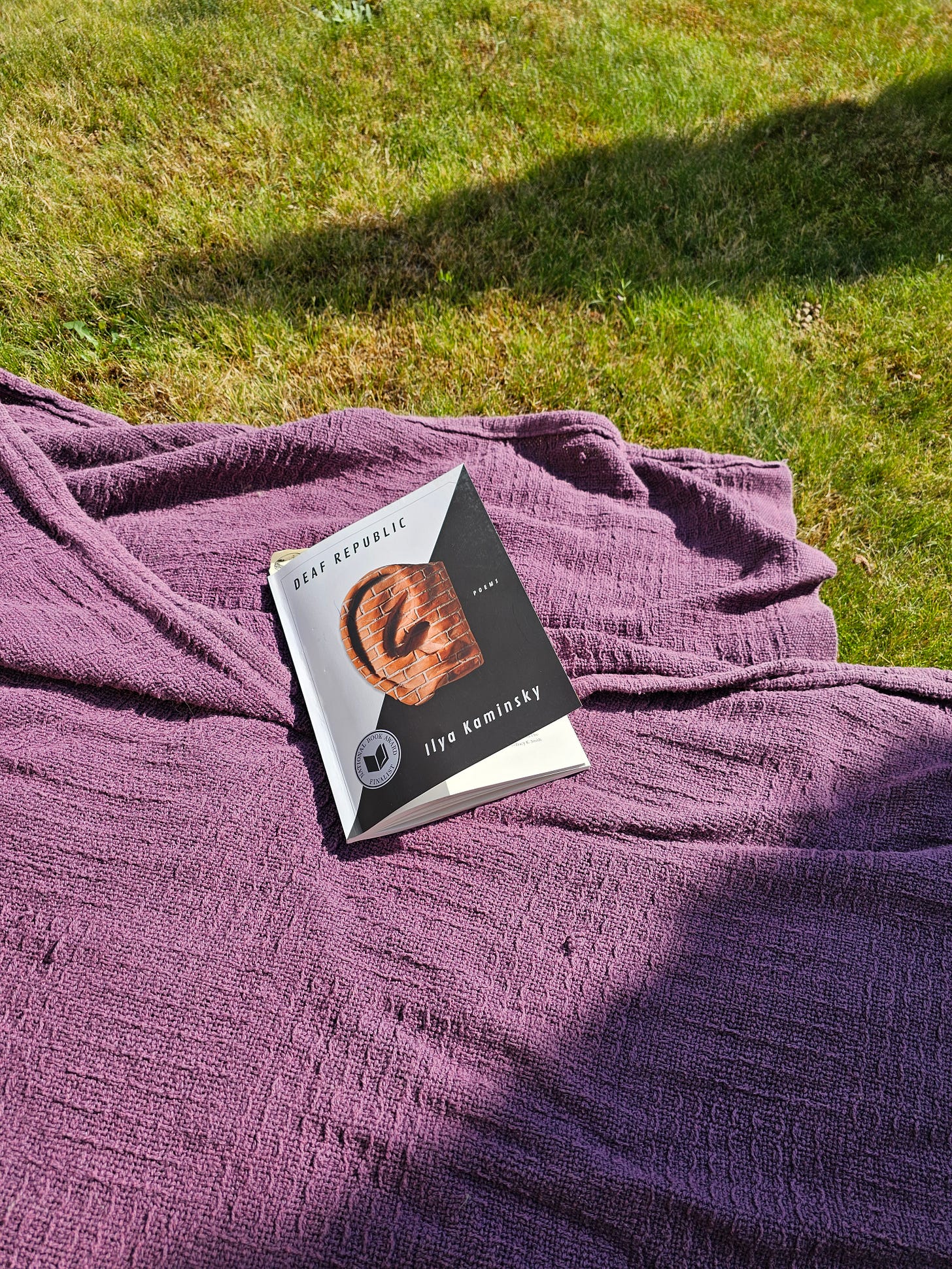Motion and Interactivity in Deaf Republic by Ilya Kaminsky
Book review and examination of the poetry collection Deaf Republic by Ilya Kaminsky.
Writing Skins is a reader supported author newsletter that shares excerpts from an award nominated speculative fiction writer’s craft journals. It offers a vulnerable, funny, and interesting look at the writing life, craft, and storytelling.
Craft Chat is the writing craft section of the newsletter where subscribers and me go through a subject, piece of media, or technique together.
Other reviews of Ilya Kaminsky’s Deaf Republic mention ‘conscience’ a couple times making me wonder if that’s close to how I read the text. One review says Kaminsky, “… created a republic of conscience,’ (Kevin Young, The New Yorker) which I have no idea what that means. Ha!
Are they saying that by creating a collective character out of the town and making them be witnesses to awful things and to feel awful things without ever going beyond intellectualizing them? Vasenka, the town that goes deaf in the wake of a child’s murder by soldiers, is not a republic of action. The other review calls it,
“… a stark appeal to our collective conscience,” (NPR.com).
Now that I get!
Deaf Republic seems to ask us not to be silent, no to be deaf. It asks us to love, to witness, and to act. It is a plea of action. While the hearing can speak and communicate without action, the deaf cannot. They must move and show in order to communicate—which may be an absolutely ableist mindset to have, but that’s how the poetry collection and its use of sign language made me feel.
The sign language was, honestly, my favorite part of the collection. Even before starting, I was intrigued to see how Kaminsky used it to add to the collection’s theme or the poems. There is an interactivity to it that makes the text more than just text or words on the page—these are actions. The first sign the readers encounter is ‘town,’ which is formed by making a pointed steeple with both your hands. It’s as though Kaminsky is asking you to form a town, feel what it’s like to create. Imagine the people that live under your hands within your control.
It makes me think about the class on giving motion to poetry and its lines. I can’t remember anything directly from the class and may have never even gone, but what I know of motion is that it never lets you forget the past even as it is forever rushing away from the now and it never lets you get comfortable. Kaminsky does both these things. Even during poems like ‘Before the War, We Made a Child,’ where the poems before and after are all much darker, reminding the reader that even in the soft times women who are loved still need medals for bravery. Kaminsky even goes as far as hinting at the coming awfulness that happens to Sonya, the love interest throughout much of the collection: “I thieved her off,” (pg. 23) and hints of death “… lying under the cool sheets.” (pg. 23) These lines show the movement toward the future that the character in the poem loving Sonya cannot change.
In Deaf Republic, the storyline is handled like a play with a poem or character list poem: ‘Dramatis Personae.’ At first glance, it seems like a simple list of the major players, but as the reader begins it carries the coming motion of the book, giving readers a taste of what is to come:
“… and on balconies, the wind fondles laundry lines” (pg. 7)
“…for soldier—finger like a beak pecks one eye …for snitch—fingers peck both eyes …for army jeep—clenched fist moves forward” (pg. 7)
“Puppets—hang on doors and porches of the families of the arrested, except for one puppet lying on the cement: a middle-aged woman wearing a child like a broken arm, her mouth filling with snow” (pg. 7)
It’s hard to read Deaf Republic at any moment in time but especially now while the events depicted in the poetry collection: little boys being shot for being kids, babies snatched or abandoned by murdered parents, genocide without any tangible reason besides power, and so many people trying to forget are being perpetrated on an every hour basis.
I think my issue with the reviews mentioning how the collection is a conscience or calls to our conscience doesn’t feel true to me. The motion in the poems and in the collection play out as a dramatization of the real world. A showing of what we do during war. Some fight. Some fuck. Some die. But in the end, we all make nice and try and remember how we lived happy, not in spite of everything, but despite it all:
“And when they bombed other people’s houses, we protested but not enough, we opposed them but not enough… in the street of money in the city of money in the country of money, our great country of money, we (forgive us) lived happily during the war.” (We Lived Happily during the Way pg. 3)



